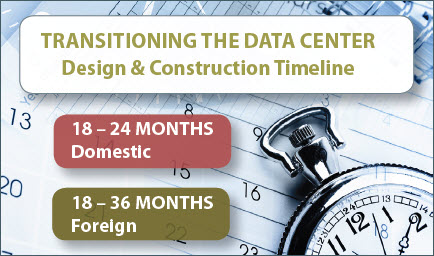This is the second article in a series on Creating Data Center Strategies with Global Scale.
It is very important for your initial plan to include one or more points earlier in the growth curve that is the trigger for the decision to transitioning away from a co-lo or hosting operation and into your own data center. This will avoid having to over expand in a co-lo or hosting operation while your new data center is being built. Once you have seen the rate of growth in the new territory reach a certain point, the earlier you are prepared to move ahead to build or buy your own data center, the more cost effective it will be.

Managing the time line for transitioning to your own data center is going to impact the initial recurring costs and capital costs as well as the time of final delivery. Design and construction of a new data center can typically range from 18-24 months domestically, but in some countries it can stretch to 36 months. One of the benefits of using larger global providers is that they have a pretty well established process and are more likely to quickly complete a project in foreign markets where they have existing operations and support staff.
New Data Center
Upon deciding that you are ready to have your own data center in a foreign location it is important to remember the underpinning of all computer resources still relies on the physical data center, which houses, protects and supports the underlying computing hardware. It still has the primary mandate of security and reliability, however data centers are no longer fixed monolithic inflexible structures. While as a whole they have become larger, they have also become more flexible in order to meet the ever changing demands of IT equipment and computing architectures. Modular expandable designs have become more mainstream, rather than leading edge, proof-of-concept demonstration examples. These newer designs allow for phased growth, ease of expanded provisioning and accommodating moves, adds and changes, rapidly and cost effectively.
Previously most large corporations and financial institutions would almost always build, own and operate their own dedicated data centers. Depending on your own organization’s type and size, performing an honest self-evaluation of core strengths and the level of design-build expertise and experience of internal resources is sometimes a difficult, but necessary task in order to help make the best Build vs Buy decision. For more information on this see part 1 of the Executive Series “Build vs Buy.”
Cross Training of Key Personnel – Differing International Standards
It is imperative that part of the strategy is to cross train key support personnel in the similarities and differences of critical systems in different locations so that they can support and monitor them remotely or even be dispatched locally if necessary.
Within your own support systems try to standardize as much a possible on the type of equipment and systems used. Time zone coordination and overlap for Network Operations Centers should be part of the global support strategy (follow the sun). Remote monitoring is crucial. It allows for a unified common knowledge base for your support staff, both for the physical facility, as well for IT systems. However, note that most other countries use the metric system, which can cause some common items to vary, such as physical dimensions of racks and differing international voltages and in particular, electrical connectors.
For example in the US, standard floor tiles are 24 inches (610mm) wide and rack cabinets are also standardized at 24" (or 30") widths. In Europe, the standard is 600 millimeters (or 750mm), so ensuring that the correct size cabinets for the locale are ordered, is a simple, but sometimes overlooked detail. The same is true for equipment power cords and rack power strips, since the plug and receptacles, as well as voltages are different in other parts of the world. Even temperature measurements for environmental monitoring and management systems will be based on the metric system, expressed in degrees Celsius instead of Fahrenheit, some basic training of staff on international conversions is suggested.
The next installment will be on Communications and Network Design Considerations. You can download a complete PDF of Creating Data Center Strategies with Global Scale by clicking here. This series is brought to you courtesy of Digital Realty.




